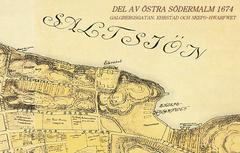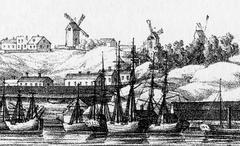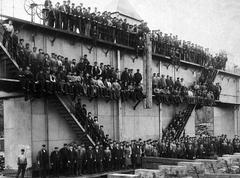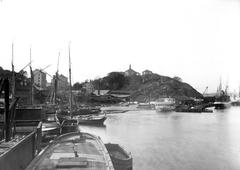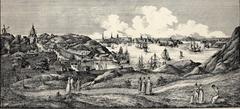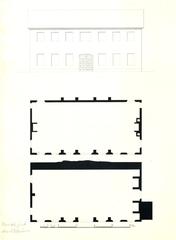
Södra Varvet Visiting Hours, Tickets & Guide to Stockholm Historical Sites
Date: 15/06/2025
Introduction to Södra Varvet’s Significance
Located on the southern shore of Södermalm, Stockholm, Södra Varvet is a key landmark in Sweden’s maritime and industrial story. Founded in 1687 by Abraham Momma, the shipyard rapidly grew into Stockholm’s largest, serving as the city’s primary center for shipbuilding. Over nearly 250 years, it produced merchant ships, naval vessels, and later, steam-powered boats that played a crucial role in expanding Swedish trade and naval power—particularly in connection with the Swedish East India Company’s lucrative routes to China and the Far East. Södra Varvet also became a symbol of industrial modernization during the 19th century, especially under engineer William Lindberg, who introduced steam engine manufacturing and iron-hulled ship construction. Although the shipyard closed in 1930, its legacy endures in preserved buildings, museum collections, and the vibrant waterfront redeveloped for modern use (Stockholmskällan; DigitaltMuseum; Sjöhistoriska museet).
Today, Södra Varvet invites visitors to experience Stockholm’s maritime heritage through scenic walks, nearby museums, and panoramic viewpoints such as Fåfängan and Erstaberget. The area blends historic ambiance with contemporary culture, making it a prime destination for history lovers, maritime enthusiasts, and casual travelers.
Table of Contents
- Introduction
- Early History (1687–1700s)
- The Age of East Indiamen
- Industrial Expansion: The Lindberg Era
- Technological Innovations & Vessels
- Decline and Closure
- Legacy & Surviving Architecture
- Visitor Information
- FAQs
- Nearby Attractions
- Planning Tips
- References
Södra Varvet’s Historical Timeline
Early History (1687–1700s)
Södra Varvet, or Stockholms stads stora skeppsvarv, was established in 1687 by Abraham Momma, a Dutch-born entrepreneur later ennobled as Reenstierna (Stockholmskällan; DigitaltMuseum). Its strategic location at Tegelviken, between Erstaberget and Fåfängan, offered direct access to Stockholm’s waterways, critical for trade and defense. By the 1700s, Södra Varvet had become Stockholm’s largest shipyard, responsible for hundreds of vessels that supported the city’s emergence as a maritime power.
The Age of East Indiamen
During the 18th century, Södra Varvet built Ostindiefarare—large merchant ships for the Swedish East India Company. These vessels connected Stockholm with China and the Far East, transporting valuable cargoes such as tea, silk, and porcelain. This era was marked by advanced shipbuilding skills and innovation. The 1748 shipbuilder’s residence (skeppsbyggmästarbostället), still standing today, is a rare architectural survivor from this period (Stockholmskällan).
Industrial Expansion: The Lindberg Era
The 19th century brought significant changes. In 1844, William Lindberg assumed leadership, guiding the shipyard into the industrial age. Södra Varvet was modernized to produce steam-powered vessels and engines. The 1877 merger with Lindberg’s mechanical workshop created W. Lindbergs Varvs- och Verkstads AB, making the yard one of Stockholm’s largest industrial employers (Stockholmskällan). The shipyard then produced passenger steamers, tugboats, and military craft, reflecting Sweden’s evolving industrial capacity.
Technological Innovations & Vessels
Södra Varvet was at the forefront of maritime technology. Notable ships include the 1897 steam launch “Yngve Frey,” powered by a 2-horsepower engine, and other advanced vessels that contributed to Swedish engineering prowess (Stockholmskällan). The shipyard also featured floating dry docks, essential for maintaining steamships. Some ships built here, such as “Norrtelje” and “Mariefred,” are preserved today as museum vessels.
Decline and Closure
Urban expansion and the development of Stadsgårdshamnen harbor in the early 20th century led to Södra Varvet’s gradual decline (DigitaltMuseum; Stockholmskällan). The final vessel was launched in 1907, and the shipyard shifted to repairs before closing completely in 1930.
Legacy & Surviving Architecture
Södra Varvet’s legacy is reflected in Stockholm’s maritime identity. The 1748 shipbuilder’s residence, the varvskontor, remains as a tangible link to the past, surrounded by contemporary developments (Stockholmskällan). Archival maps, photographs, and models are preserved at the Swedish National Maritime Museum, providing a window into the site’s industrial evolution (DigitaltMuseum).
Visitor Information
Hours & Tickets
- Södra Varvet Site: Outdoor areas are open 24/7 year-round; no ticket required for the waterfront or public spaces.
- Sjöhistoriska Museet: Museum exhibitions are open Tuesday–Sunday, 10:00–17:00; closed Mondays. General admission is often free, but special exhibitions or guided tours may require a ticket—check the official museum website for details.
- Nearby Attractions: Fotografiska (10:00–23:00, ticketed), Viking Line terminal (open daily, ferry tickets required), and Fåfängan café (open seasonally).
Accessibility
- The promenade and ferry terminal are wheelchair accessible.
- Some historic buildings and paths, especially to Fåfängan, may be steep or uneven—plan accordingly.
- Public toilets are available at major venues; accessible restrooms at the museum and Fotografiska.
Guided Tours & Events
- Walking tours of Södermalm and the waterfront often include Södra Varvet’s history (Free Tours by Foot).
- Sjöhistoriska museet and local societies occasionally offer guided tours in English and Swedish—advance booking recommended.
- Seasonal maritime festivals and boat shows celebrate Stockholm’s nautical tradition (Visit Stockholm Events).
Photo Opportunities
- The varvskontor, waterfront, and panoramic views from Fåfängan are ideal for photography.
- Early morning and late afternoon provide the best natural lighting.
Frequently Asked Questions (FAQ)
Q: Are tickets required to visit Södra Varvet?
A: No, the outdoor areas are open to the public. Tickets are only needed for museum exhibits, guided tours, and ferry rides.
Q: What are Södra Varvet’s visiting hours?
A: Public areas are accessible 24/7. Museum and attraction hours vary—check their websites for current info.
Q: Is the site accessible for wheelchairs and strollers?
A: Most of the promenade is accessible, but some older structures may have limitations.
Q: Can I join a guided tour in English?
A: Yes, guided tours are available in English and Swedish, especially through the Sjöhistoriska museet.
Q: Are there restaurants nearby?
A: Yes, Södermalm offers a range of cafés and eateries, with Fotografiska’s restaurant being a local highlight.
Nearby Attractions
- Fotografiska: Internationally renowned photography museum in Stora Tullhuset, with rotating exhibitions and a sustainable restaurant (Fotografiska).
- Fåfängan: A scenic viewpoint and seasonal café with panoramic views of Stockholm (Stockholmshamnar).
- Gamla Stan (Old Town): Medieval streets and the Royal Palace, a short walk or bus ride away (Nomad Epicureans).
- Stadsgårdshamnen Promenade: Ideal for walks, cycling, and observing ferry and cruise traffic (Stockholmshamnar).
Planning Tips
- Dress in layers and bring a light jacket, as weather can change quickly by the water.
- Wear sturdy shoes for cobblestone and uneven paths.
- Use public transport to avoid parking hassles; the area is well-connected by metro, bus, and ferry (Visit Stockholm).
- Respect local customs, recycle, and keep noise to a minimum in residential areas (Visit Sweden).
Visuals and Interactive Resources
- Access high-quality images and virtual tours via museum and tourism websites.
- Look for interpretive signage along the promenade for historical context.
- Use digital resources like DigitaltMuseum for archival materials and virtual exhibits.
Summary
Södra Varvet embodies Stockholm’s transformation from a 17th-century trade center to a modern metropolis, with its maritime legacy preserved in architecture, museums, and waterfront life. The area offers a seamless blend of history and contemporary urban culture, making it a must-visit for anyone eager to explore Stockholm’s nautical roots. For an enriched experience, combine your visit with guided tours, nearby attractions, and digital resources. Always practice sustainable tourism to help preserve this vital heritage site for future generations (Stockholmskällan; DigitaltMuseum; Visit Stockholm).
References and Further Reading
- Stockholmskällan
- DigitaltMuseum
- Sjöhistoriska museet
- Stockholmshamnar
- Visit Stockholm
- Fotografiska
- Nomad Epicureans
- Visit Sweden
- The Crazy Tourist
- Free Tours by Foot
- Strömma
